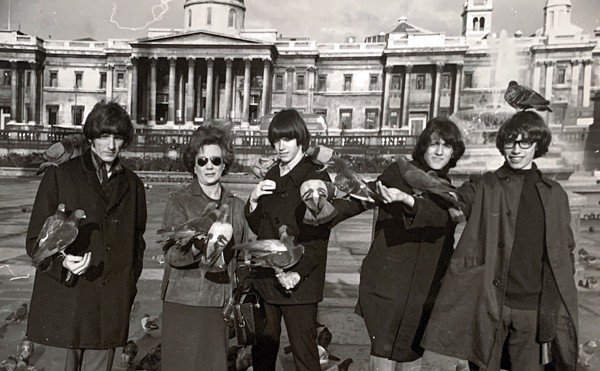If you're mad enough to be among those still trying to figure out what makes Thomas Alan Waits tick, you could do worse than to just reflect on the tools of his trade. There's the piano, of course, at the heart of his first recordings in the early '70s, and still his most effective ally. And then there are the kitsch strings, brass and woodwinds that gave the huckster jazz poet the musical-theater air he's been deliriously contaminating and ventilating through the four decades of his artfully dodgy career.
But then in 1983 came the weapons of mass deconstruction and deception: angklung, bagpipes, marimba, optigan, pan flutes and pipes, chamberlain, calliope, timpani, a violin with a horn growing out of it. Waits began to choose instruments with built-in onomatopoeia and he beat-boxed them and clacked them with sticks: When the instruments didn't exist, he invented them himself.
The question is, Why? The answer is simple: So he wouldn't turn into Scarlett Johansson.
It could have happened. The yawning deficit of inspiration and meaning that is Anywhere I Lay My Head (Johansson's new album of Tom Waits covers) owes less to ScarJo's complete inability to sing, and more to her inability to think about what she's singing, to reflect on who she is and what the hell she might be doing. A lack of self-consciousness is usually a virtue, even a necessary one, in popular music. Waits' musical role models, from Howlin' Wolf to Captain Beefheart to Lead Belly to Bob Dylan, only seem instinctive and spontaneous. But their power and creativity derives much from knowing themselves and their craft so well — and channeling that power in order to make your head and heart spin.
Waits didn't always know what he was doing. When he was wasting his always-evident lyrical talent on pseudo-bohemian diner jive in the '70s, rock critic dean Robert Christgau wrote, "Waits is so full of shit, Port-O-San ought to name a model after him." But it wasn't so much the grotesque Americana put-on, the counterfeit cartoons of 3 a.m. delinquents and derelict romantics, as it was a failure of nerve and imagination about what to do with all the grimy mess of his imagination. He was writing gorgeous and gritty songs — inarguable classics such as "Old 55," "Jersey Girl" and "The Heart of Saturday Night" — but he wasn't making them live in unpredictable ways.
On the pivotal Swordfishtrombones, all of that changed. Waits raised the ante on all the put-ons through the roof. The percussive power of the record is like an exorcism. Time signatures refract and bend and skitter, horns honk up against bongos and drums played as if by a marauding polyethnic army. The album pulls at the seams of an American musical fabric and finds worlds buried underneath — still a drunken, violent, outcast world, but a world that seems alive because it beats by a hundred unique human hearts.
Even better was Rain Dogs, in part because of Marc Ribot's mathematically convoluted guitar, but mostly because the percussive experiments were pushed by the songs, and not the other way around. He also seemed to be rediscovering the value and power of a great melody, which is the key to "Downtown Train," a song that deserved a better hit version than Rod Stewart's. The collaboration with wife Kathleen Brennan, "Hang Down Your Head," is Waits fully making sense of the language of American folk music, fully on his own emotional terms.
Waits has never been reluctant to give praise or credit to Brennan, who is the animating spirit behind his best album, Mule Variations (which won a Grammy for Best Contemporary Folk Album in 2000, one of the few times the judges got the award right). The album is a long, hard, warm-hearted look at blues and country, and only seems like a conventional retreat. He's never been funnier than on "Eyeball Kid" or "Come On Up to the House," with the lines, "Come down off the cross/We can use the wood." And no songwriter has ever asked more heartbreaking questions than on "Georgia Lee": "Why wasn't God watching? Why wasn't God listening?"
Though he's beloved as a verbal trickster and a musical heretic, Waits can still be at his most powerful when at his most sincere. While he delights in hoaxes and frauds, and dares his audience to find meaning in his snake oil spoofs, to be snookered and to beg for more, he always returns to the not-so-simple truths of not-so-simple lives. The whole beat box mess of 2004's Real Gone is redeemed by one song: "The Day After Tomorrow." It's a soldier's letter back home to Rockford, Illinois, and it speaks of feelings Waits can't know but which he still embodies. The soldier who misses shoveling snow and raking leaves isn't another costume for Waits. "I still don't know how I'm supposed to feel/About all the blood that's been spilled." He can't know, no one can, and it's his genius just to recognize the truth of that.
Waits' last release (2006's Orphans) is more than just another major artist's attempt to get back at the bootleggers. He revisits neglected, unknown and forgotten songs from all over his career, tinkers with some, leaves others alone in demo form, and records a bunch more. The result is the most representative and strange single package he's ever released. All of the noisy blues, tender jazz, baloney spoken-word, gossamer folk and grinding metal marches fit together, though smartly sequenced across three thematic discs. He's ever so artful with his bullshit and ever so hands-off with his sincerity. When he calls out, "I'm lost at the bottom of the world," he's asserting the place where he works best, the vantage point from which he can best see himself — and everything else, for that matter. No one really believes he's lost in the weirdest of the weirdest American experiences. But anyone who hears his wretched, hilarious and soulful howl would want to follow him there all the same.





